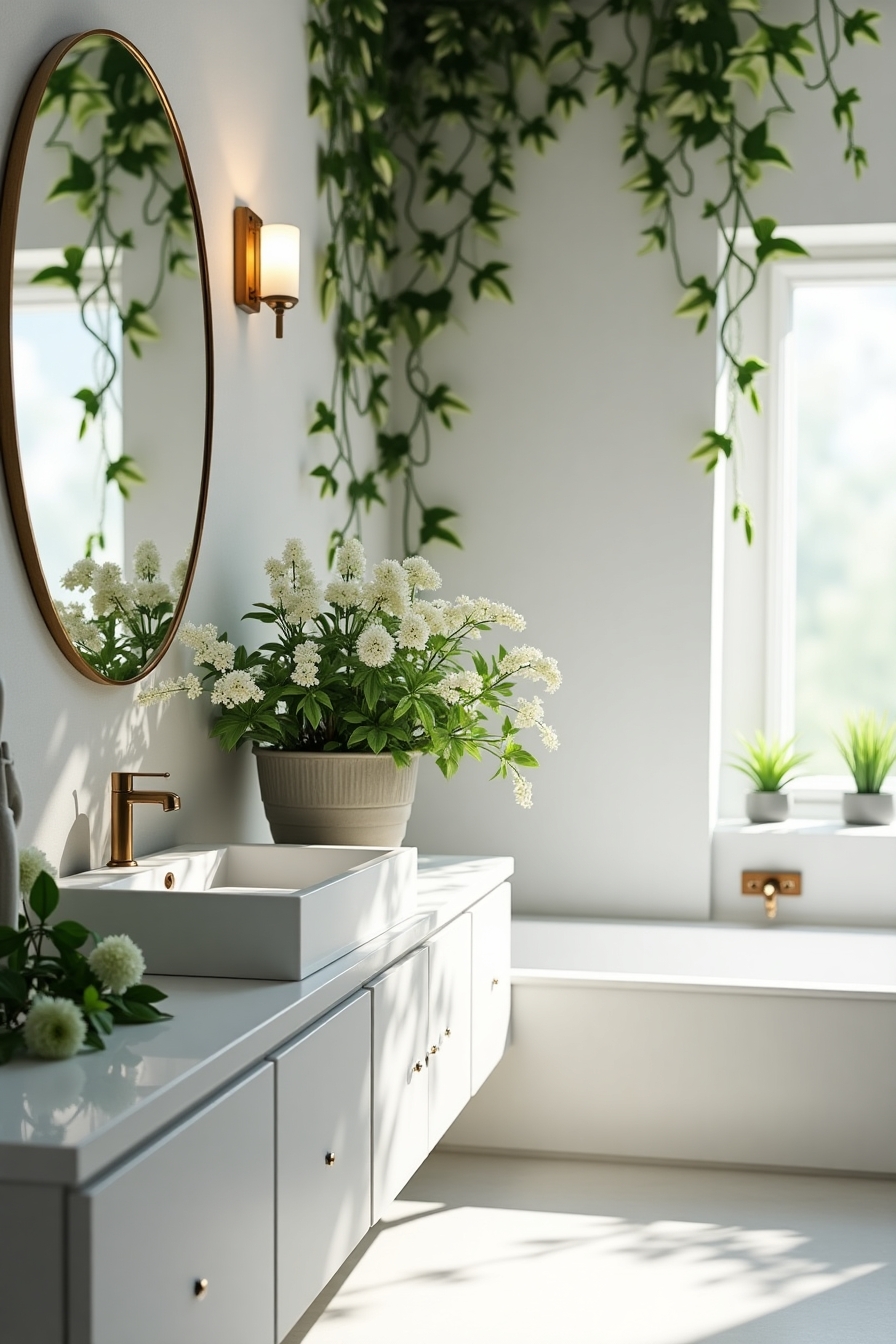Bathrooms often harbor humidity, chemicals from cleaning products, and limited ventilation – creating the perfect storm for poor air quality right where you start and end your day.
Adding plants to this space isn’t just about décor – it’s a natural way to filter toxins, absorb excess moisture, and create a spa-like atmosphere that benefits both your home and health.
The following plants thrive in bathroom conditions while working overtime to purify your air, turning an ordinary bathroom into a refreshing sanctuary.
✨Click to Get My 101 FREE Designer Room Ideas
Snake Plant (Sansevieria): The Overnight Air-Cleaner
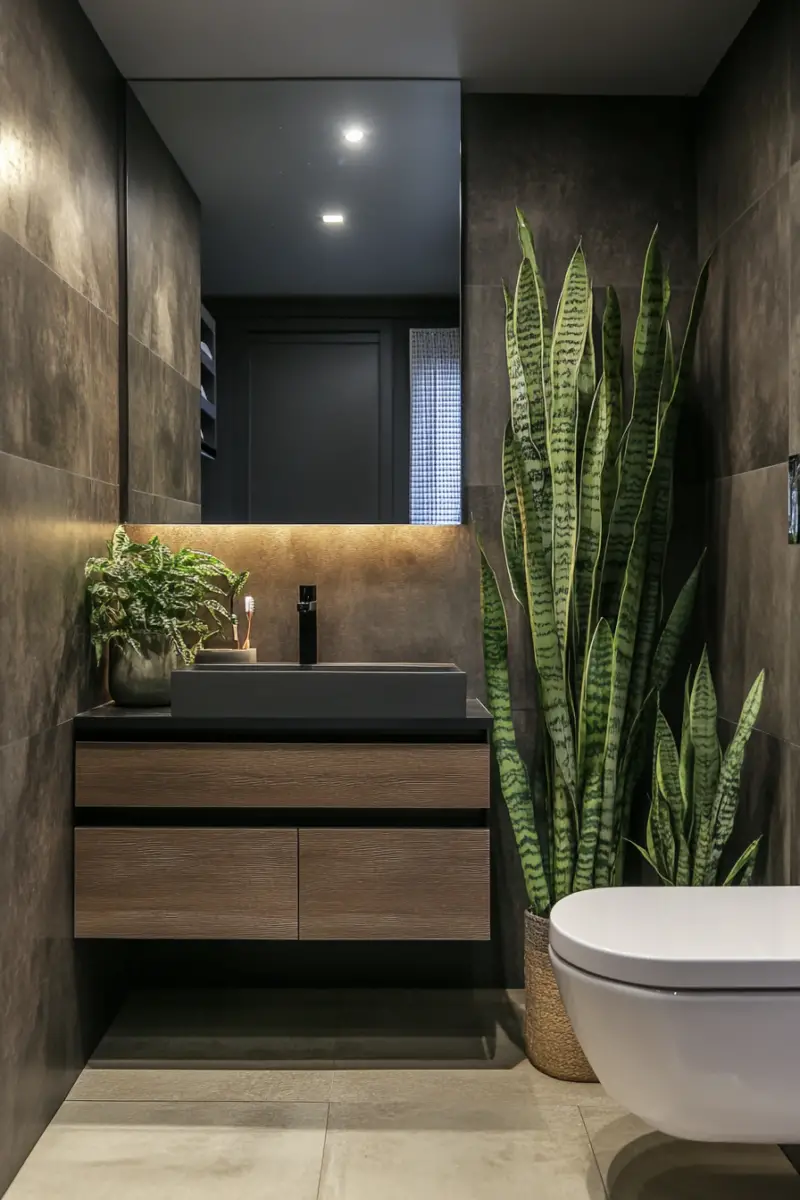
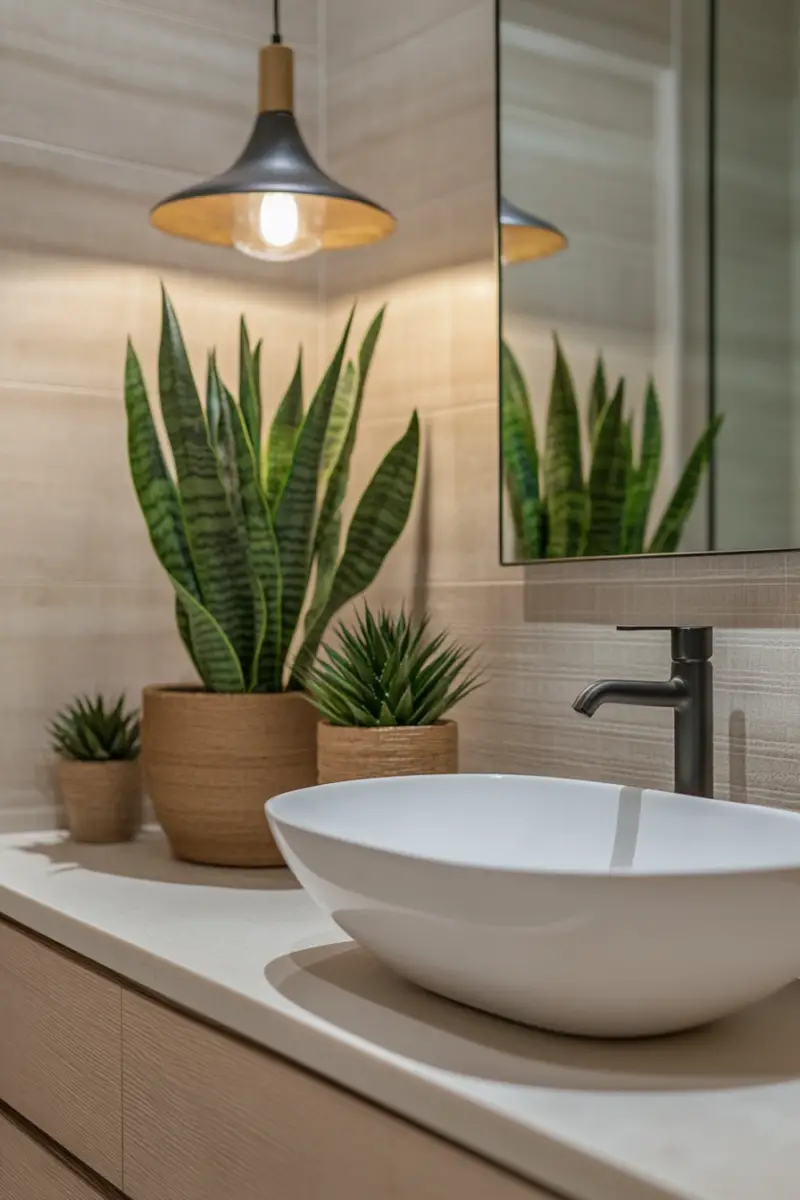
Snake plants stand tall with their striking sword-shaped leaves, bringing architectural interest to any bathroom corner.
These resilient plants are NASA-approved air purifiers, known for removing formaldehyde, benzene, xylene, and trichloroethylene from indoor air.
What makes snake plants perfect for bathrooms is their ability to convert carbon dioxide into oxygen at night – unlike most plants that only do this during daylight.
You’ll appreciate how snake plants thrive in low light conditions, making them suitable for bathrooms with small or frosted windows.
Their water requirements are minimal – watering once every 2-3 weeks is sufficient, as they store moisture in their thick leaves.
Snake plants can handle the humidity fluctuations typical in bathrooms, from steamy showers to drier periods when the bathroom isn’t in use.
The upright growth pattern means they fit perfectly on countertops, toilet tanks, or floor corners without taking up much horizontal space.
These plants are virtually indestructible – even with irregular care, they continue purifying your air for years.
The variegated varieties with yellow or white edges bring a touch of color that complements most bathroom color schemes.
You’ll notice fewer allergy symptoms over time, as snake plants are excellent at removing airborne allergens.
The smooth, waxy texture of snake plant leaves makes them easy to dust and keep clean in bathroom environments.
For small bathrooms, consider the compact “Bird’s Nest” snake plant variety that delivers the same air-purifying benefits in a smaller package.
Peace Lily (Spathiphyllum): The Shower-Loving Toxin Remover
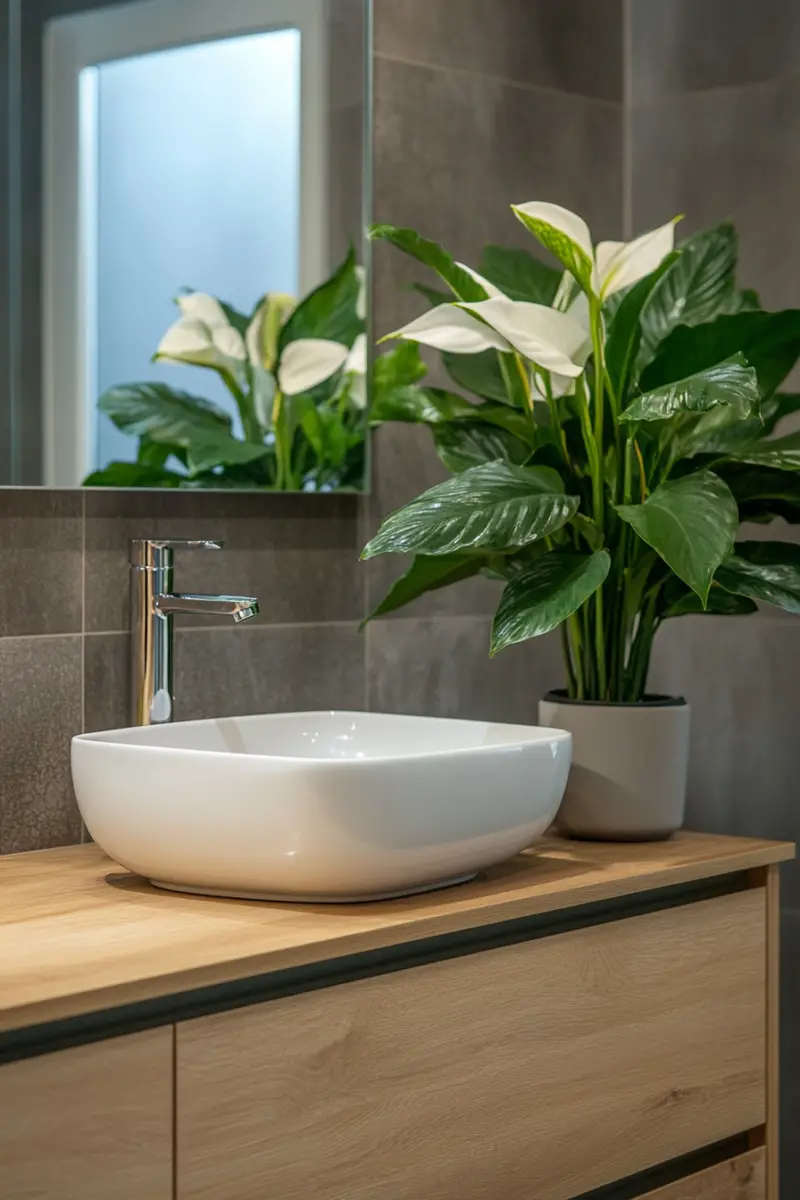
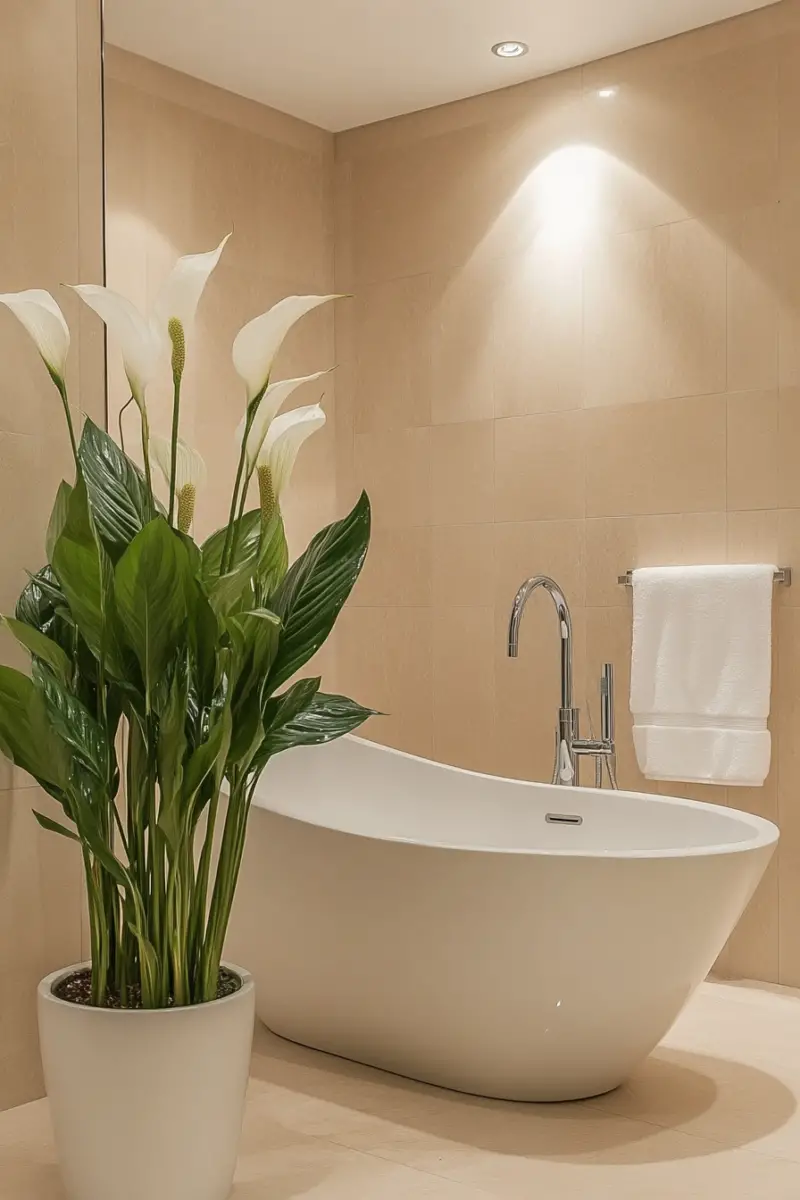
Peace lilies bring elegant white blooms and glossy green leaves to your bathroom, creating a striking contrast against typical bathroom finishes.
These powerful purifiers are exceptional at removing ammonia, benzene, formaldehyde, and trichloroethylene – common bathroom toxins found in cleaning products.
Your peace lily will thrive in the indirect light and humid conditions naturally present in most bathrooms.
Peace lilies dramatically signal when they need water by drooping their leaves, making them perfect for busy people who might forget regular watering schedules.
The NASA Clean Air Study ranked peace lilies among the top plants for removing indoor pollutants, confirming their status as bathroom air-cleaning champions.
You’ll discover that peace lilies can reduce spore counts of mold and mildew – common bathroom problems that affect air quality and health.
These plants prefer temperatures between 65-80°F, making them ideal for the consistent climate maintained in most bathrooms.
Peace lilies require minimal fertilization – feeding them once in spring and summer is sufficient for healthy growth and continued air purification.
Their compact root systems mean they won’t quickly outgrow bathroom containers, reducing the need for frequent repotting.
The distinctive white flowers (actually modified leaves called spathes) provide a spa-like aesthetic that elevates your bathroom’s appearance.
You should place peace lilies away from drafts or air vents to maximize their air-cleaning capabilities.
Peace lilies are particularly effective at removing acetone – found in nail polish removers often used in bathrooms – making them practical as well as beautiful.
Boston Fern (Nephrolepis exaltata): The Humidity-Loving Moisture Regulator

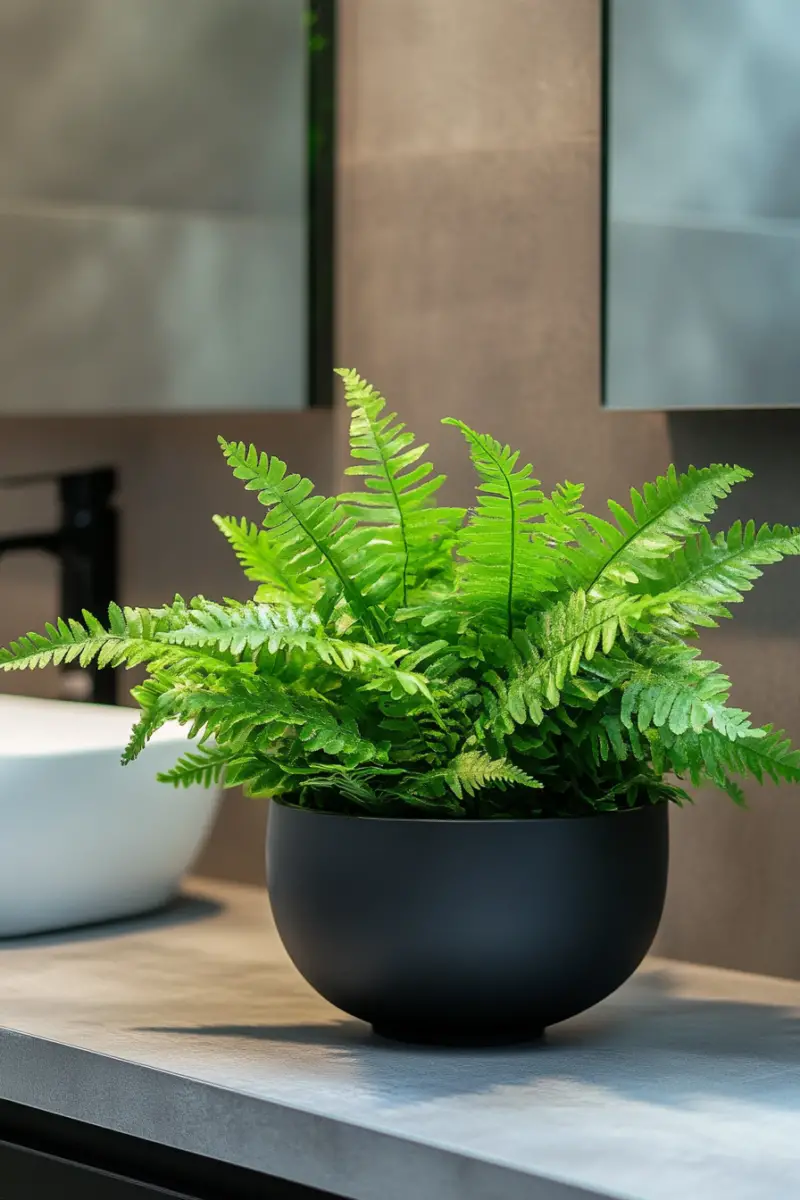
Boston ferns feature delicate, arching fronds that create a waterfall effect, perfect for softening the hard edges commonly found in bathroom designs.
These classic beauties are champion air purifiers, particularly excelling at removing formaldehyde – a common component in bathroom products like toilet paper and facial tissues.
Your Boston fern will thrive in the naturally humid environment created by daily showers, making the bathroom its ideal habitat.
Boston ferns act as natural humidifiers, releasing moisture into the air and creating a more comfortable breathing environment.
The lush, feathery appearance brings a touch of woodland serenity to your bathroom, transforming the space into a natural retreat.
You’ll find Boston ferns particularly effective at filtering xylene and toluene – chemicals found in many bathroom cleaners and personal care products.
These plants prefer indirect light, making them perfect for bathrooms with north or east-facing windows that provide gentle morning sun.
Boston ferns can adapt to hanging baskets, shelves, or plant stands, allowing you to maximize vertical space in smaller bathrooms.
The vibrant green color of healthy Boston fern fronds creates a refreshing visual impact that enhances any bathroom color scheme.
You should mist your Boston fern regularly during winter months when heating systems can reduce indoor humidity levels.
These ferns have been proven to reduce airborne microbes, potentially decreasing the spread of bathroom-related germs.
Boston ferns grow relatively quickly in ideal conditions, providing increasingly better air purification as they mature and produce more foliage.
Pothos (Epipremnum aureum): The Low-Maintenance Air Detoxifier
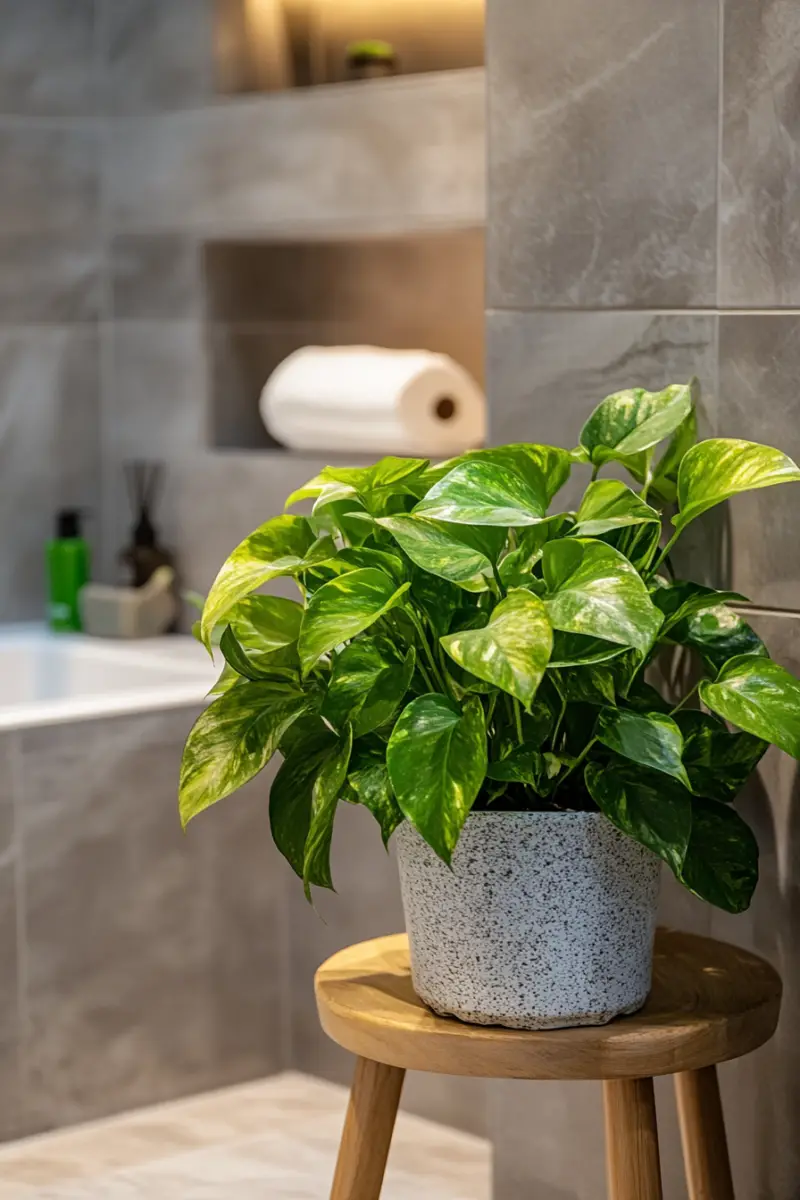
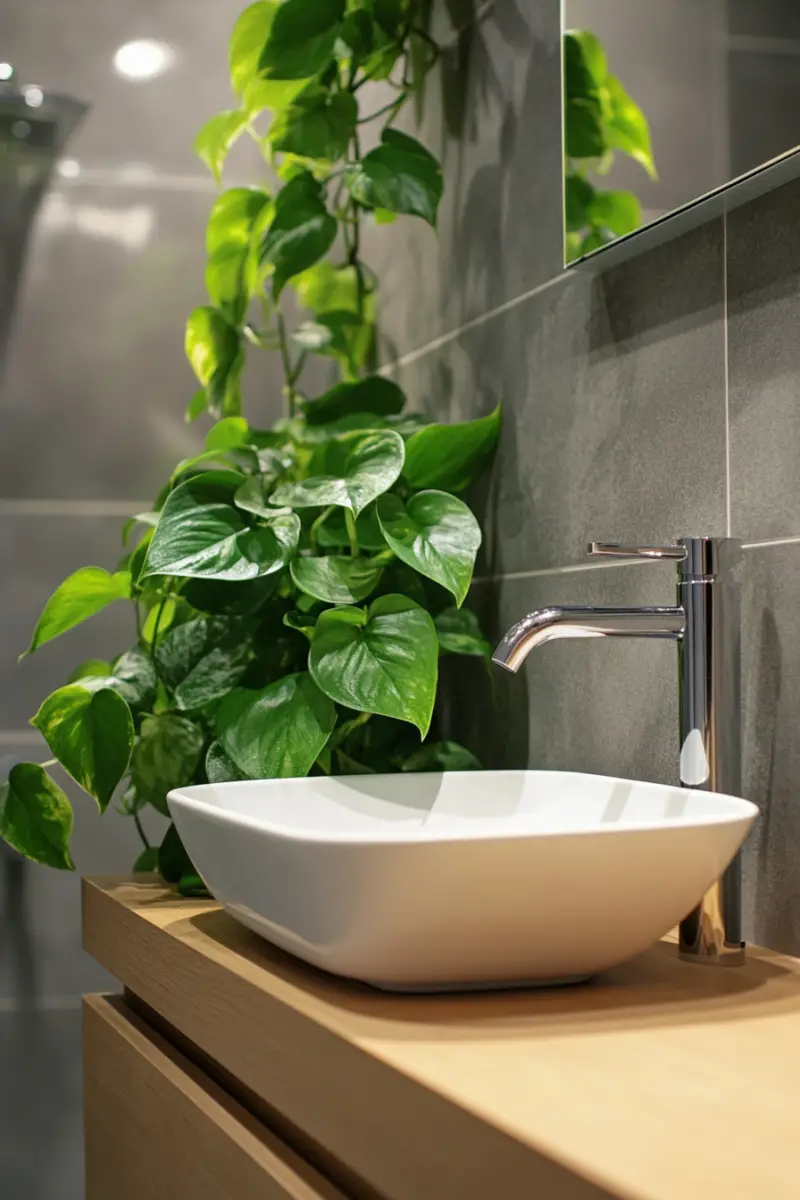
Pothos plants showcase heart-shaped leaves on cascading vines that can transform your bathroom into a verdant retreat.
These adaptable plants come in varieties ranging from golden-streaked to marbled white, allowing you to choose the perfect accent for your bathroom color scheme.
Your pothos will efficiently remove formaldehyde, benzene, and carbon monoxide from bathroom air, significantly improving the quality of every breath you take.
Pothos thrives in both bright indirect light and low light conditions, making it suitable for nearly any bathroom regardless of window placement.
The trailing growth habit makes pothos ideal for placement on high shelves or in hanging planters, allowing the vines to create a waterfall effect that softens bathroom architecture.
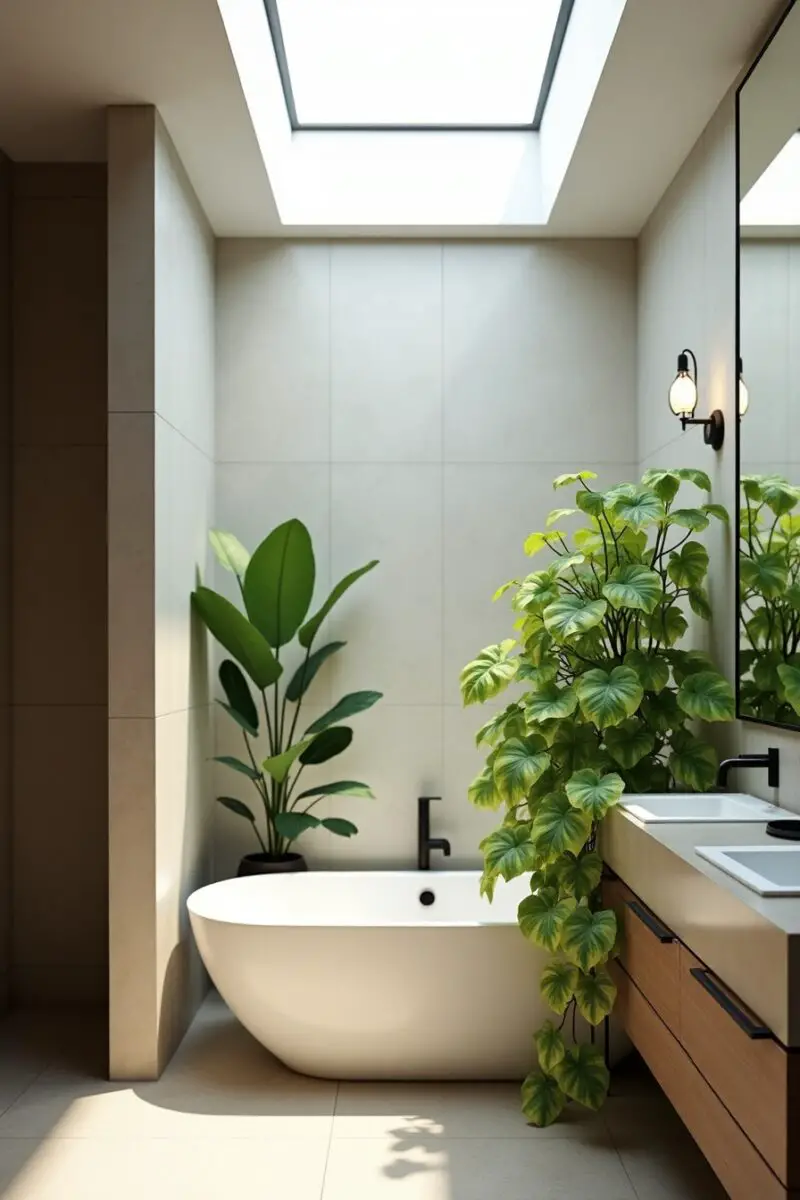
You’ll appreciate how pothos requires watering only when the soil feels dry to the touch – typically every 7-10 days in bathroom environments.
These resilient plants can tolerate inconsistent care, making them perfect for busy households or those new to plant parenthood.
Pothos plants grow quickly in favorable conditions, rapidly increasing their air-purifying capacity as they produce more foliage.
The waxy leaves of pothos are particularly effective at trapping airborne bathroom particulates that can irritate lungs and skin.
You can easily propagate pothos by cutting a vine segment with a node and placing it in water – creating new plants to expand your bathroom air-purifying network.
These plants have been shown to reduce carbon monoxide levels by up to 73% in controlled studies, making them exceptional air scrubbers.
Pothos plants remain effective air purifiers even in artificial light, meaning they can thrive in windowless bathrooms with only overhead lighting.
✨Click to Get My 101 FREE Designer Room Ideas
Spider Plant (Chlorophytum comosum): The Reproductive Air-Cleaning Powerhouse

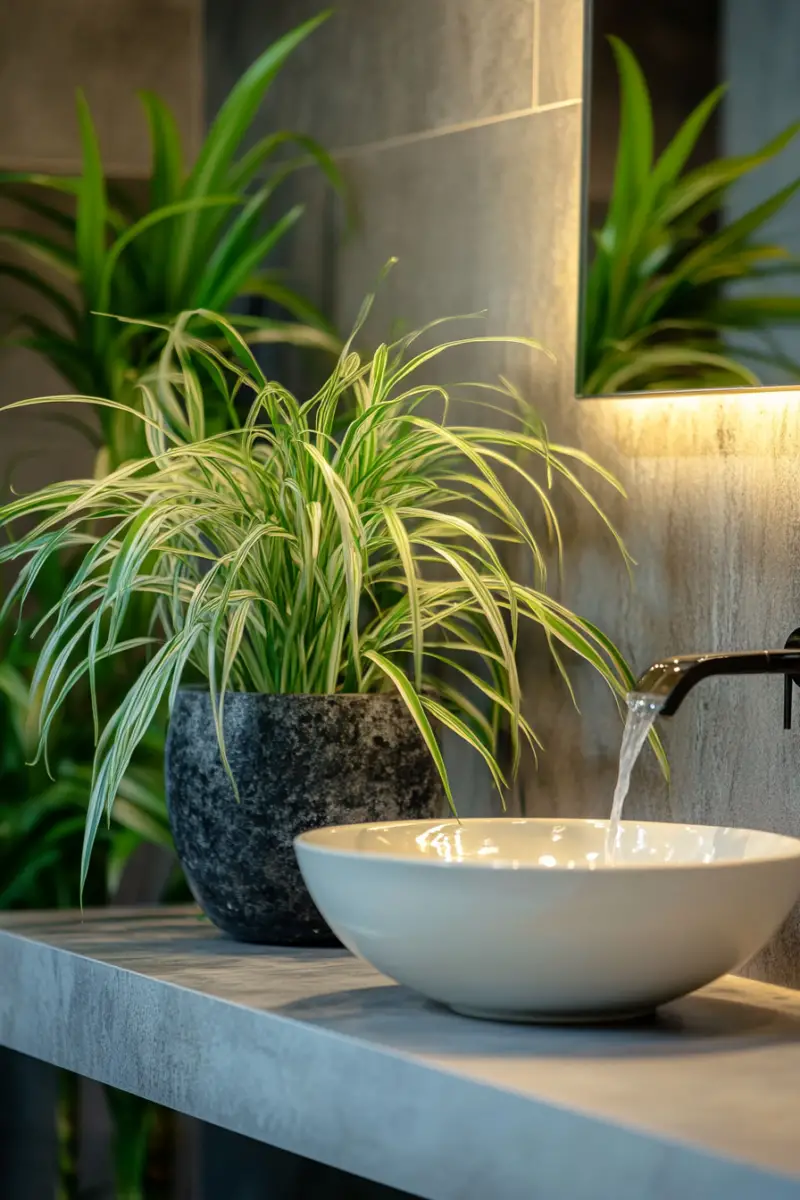
Spider plants feature arching, ribbon-like leaves with distinctive white stripes, creating movement and visual interest in bathroom spaces.
These prolific growers are known for producing numerous “spiderettes” – baby plants that dangle from the mother plant on long stems, creating a dynamic, living mobile effect.
Your spider plant excels at removing carbon monoxide, formaldehyde, xylene, and toluene from the air – all potential bathroom pollutants.
Spider plants thrive in bright, indirect light but tolerate lower light conditions, making them versatile for various bathroom window exposures.
The NASA Clean Air Study identified spider plants as removing up to 95% of toxic substances in closed environments within 24 hours.
You’ll find spider plants particularly effective at combating off-gassing from vinyl shower curtains and plastic bathroom accessories.
These hardy plants adapt well to bathroom humidity fluctuations, maintaining their air-cleaning abilities throughout steamy showers and drier periods.
Spider plants are completely non-toxic to pets and children, providing peace of mind if you have curious family members or visitors.
The cascading growth habit makes them perfect for bathroom shelves or hanging planters where their baby plants can be showcased.
You can easily propagate the baby spiderettes by placing them in water until roots develop, then potting them up – creating an endless supply of air purifiers.
Spider plants naturally filter out airborne allergens, potentially reducing allergy symptoms for bathroom users.
These resilient plants communicate their needs clearly – brown tips often indicate too much fluoride in tap water, signaling when filtered water might be beneficial.
Aloe Vera: The Healing Air Monitor
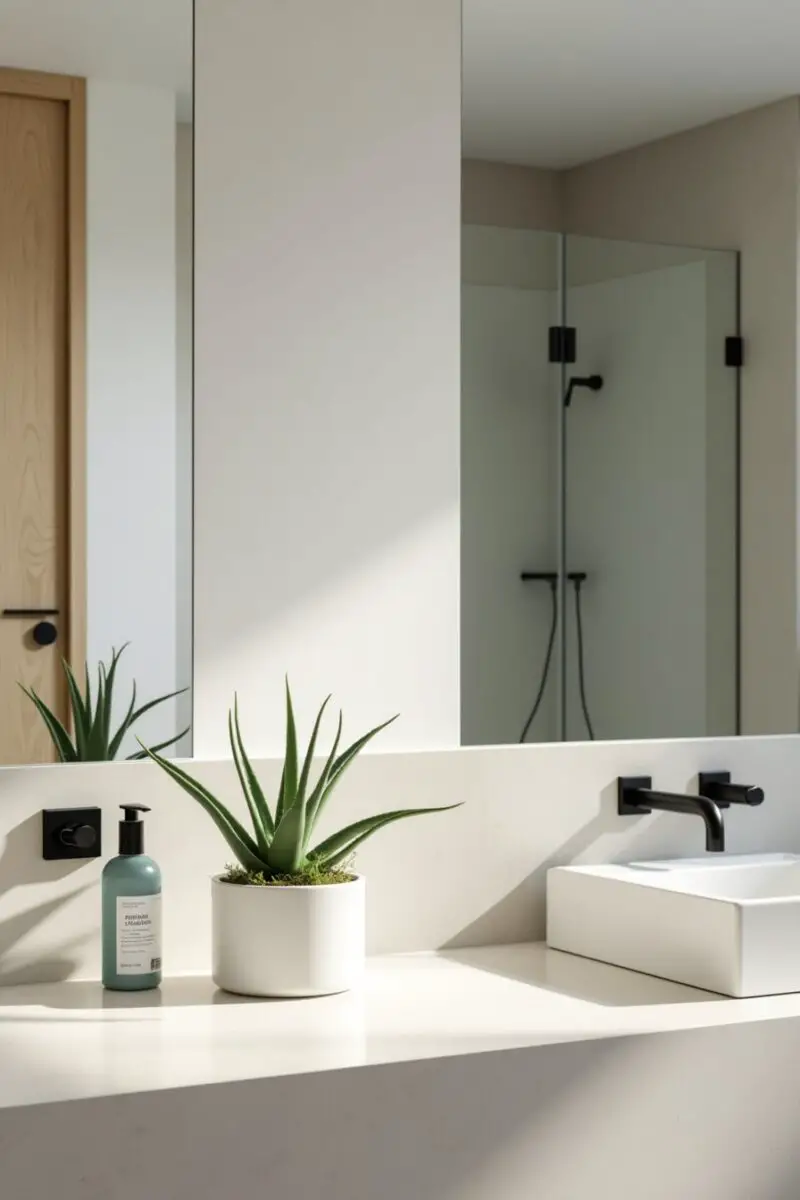
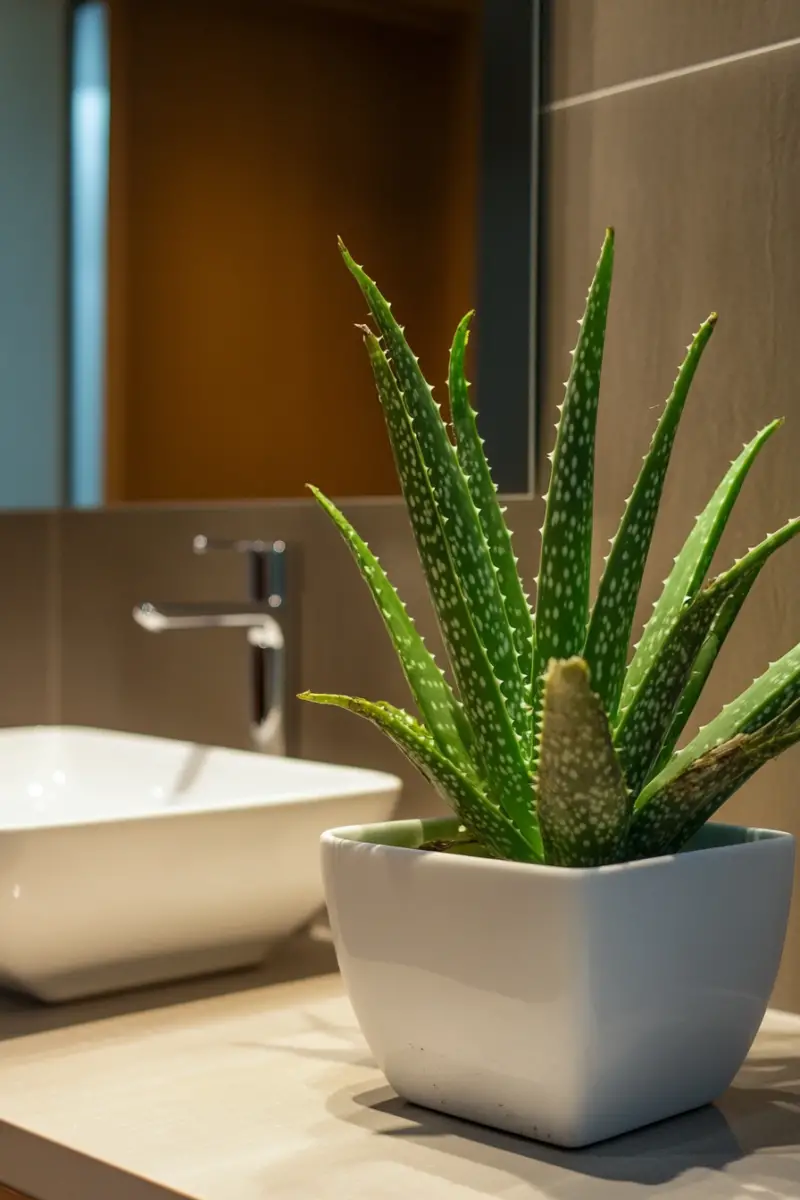
Aloe vera plants display thick, succulent leaves with subtle spikes, bringing architectural interest and a modern aesthetic to bathroom spaces.
These dual-purpose plants not only purify the air but also provide a readily available first-aid treatment for minor burns, cuts, and skin irritations.
Your aloe vera effectively filters benzene and formaldehyde from the air – chemicals commonly found in bathroom cleaning products and air fresheners.
Aloe plants prefer bright, indirect light, making them ideal for bathrooms with windows that receive several hours of filtered sunlight.
The unique characteristic of aloe vera to develop brown spots when excessive pollutants are present makes it a living air quality monitor for your bathroom.
You’ll appreciate aloe’s minimal watering needs – allowing the soil to dry completely between waterings makes it ideal for those who sometimes forget plant care.
Aloe vera plants release oxygen and absorb carbon dioxide at night, improving air quality while you sleep if placed in an adjacent bathroom.
The gel inside aloe leaves contains antibacterial, antifungal, and anti-inflammatory properties – beneficial qualities that complement its air-purifying abilities.
Aloe plants require well-draining soil and pots with drainage holes to prevent root rot in humid bathroom environments.
You can easily propagate aloe by removing and replanting the offsets (pups) that grow around the base of mature plants.
These succulent plants store water in their leaves, helping to regulate bathroom humidity by releasing moisture gradually into the air.
Aloe vera’s compact growth habit makes it perfect for bathroom countertops, window sills, or toilet tanks where space may be limited.
English Ivy (Hedera helix): The Mold-Fighting Climber
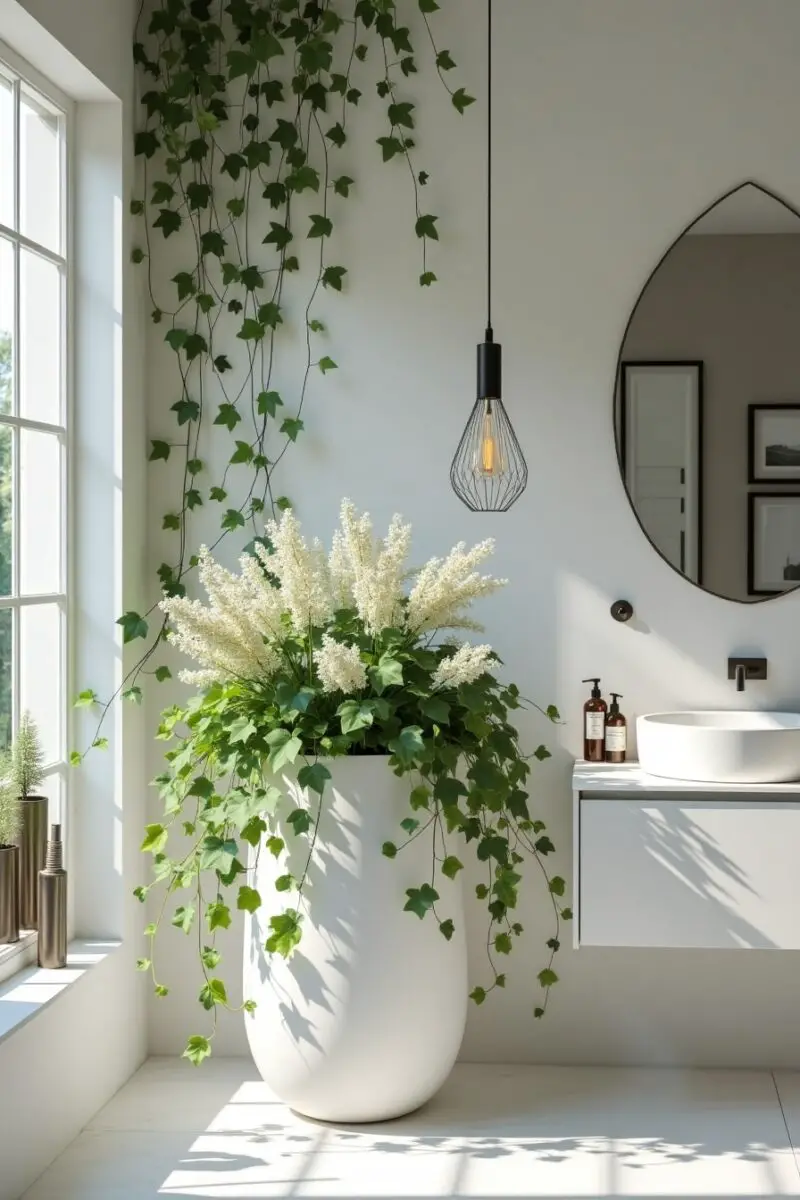
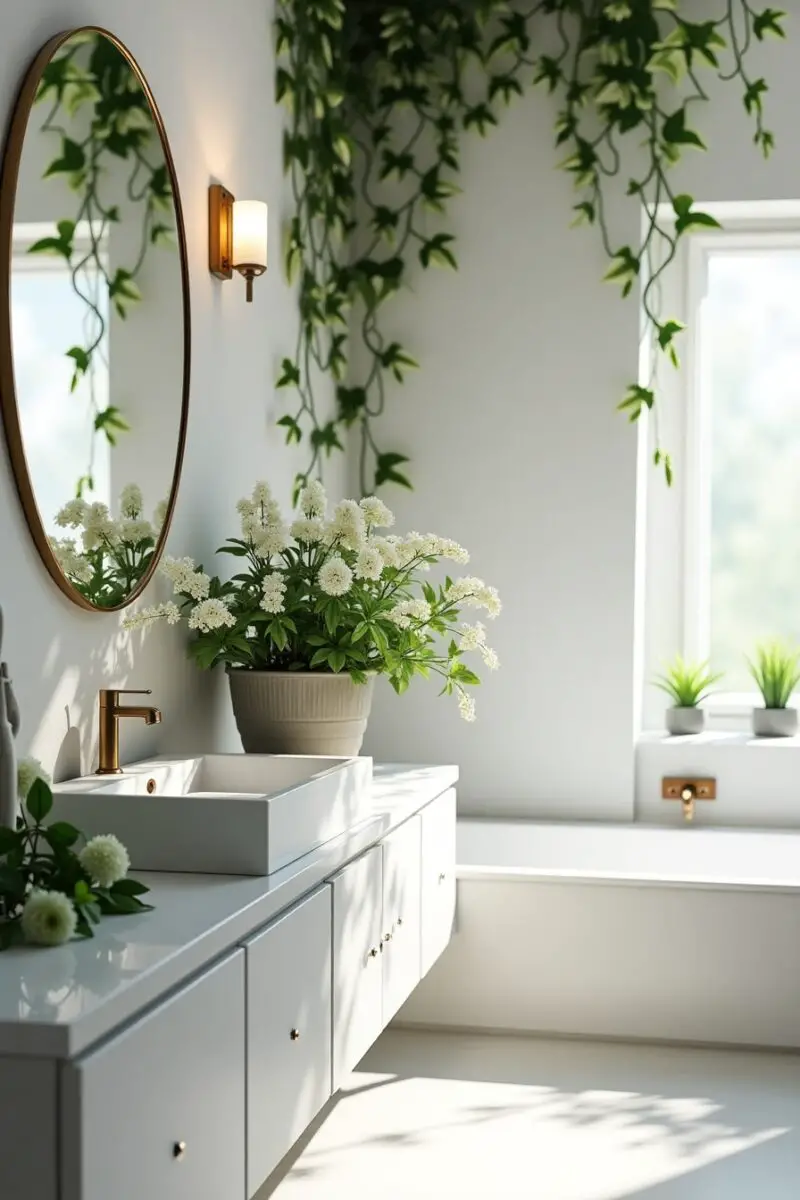
English ivy features elegant, lobed leaves with distinctive veining patterns that create visual texture and old-world charm in bathroom spaces.
These adaptable vines are proven to reduce airborne mold spores by up to 60%, making them particularly valuable in humid bathroom environments.
Your English ivy effectively filters benzene, formaldehyde, xylene, and toluene from bathroom air, addressing pollutants from various sources.
English ivy thrives in moderate indirect light but adapts to lower light conditions, making it suitable for most bathroom placements.
The American College of Allergy, Asthma and Immunology found that English ivy can help reduce indoor airborne fecal matter particles – a significant concern in bathroom spaces.
You’ll appreciate how English ivy can be trained to climb bathroom walls or trellises, or allowed to cascade from high shelves, maximizing its air-purifying surface area.
These versatile plants prefer consistent moisture and humid environments, making bathrooms an ideal habitat where they’ll thrive with minimal effort.
English ivy’s ability to reduce airborne mold may help prevent bathroom mildew and the respiratory issues associated with mold exposure.
The variegated varieties with white or yellow leaf margins add a decorative touch that brightens darker bathroom corners.
You should mist English ivy occasionally to remove dust that can accumulate on the leaves and reduce its air-cleaning efficiency.
These plants grow relatively quickly in favorable conditions, providing increasingly better air filtration as they produce more foliage.
English ivy is particularly effective at removing airborne particles linked to allergies, potentially creating a more comfortable bathroom environment for allergy sufferers.
Plant (Zamioculcas zamiifolia): The Virtually Indestructible Air Purifier
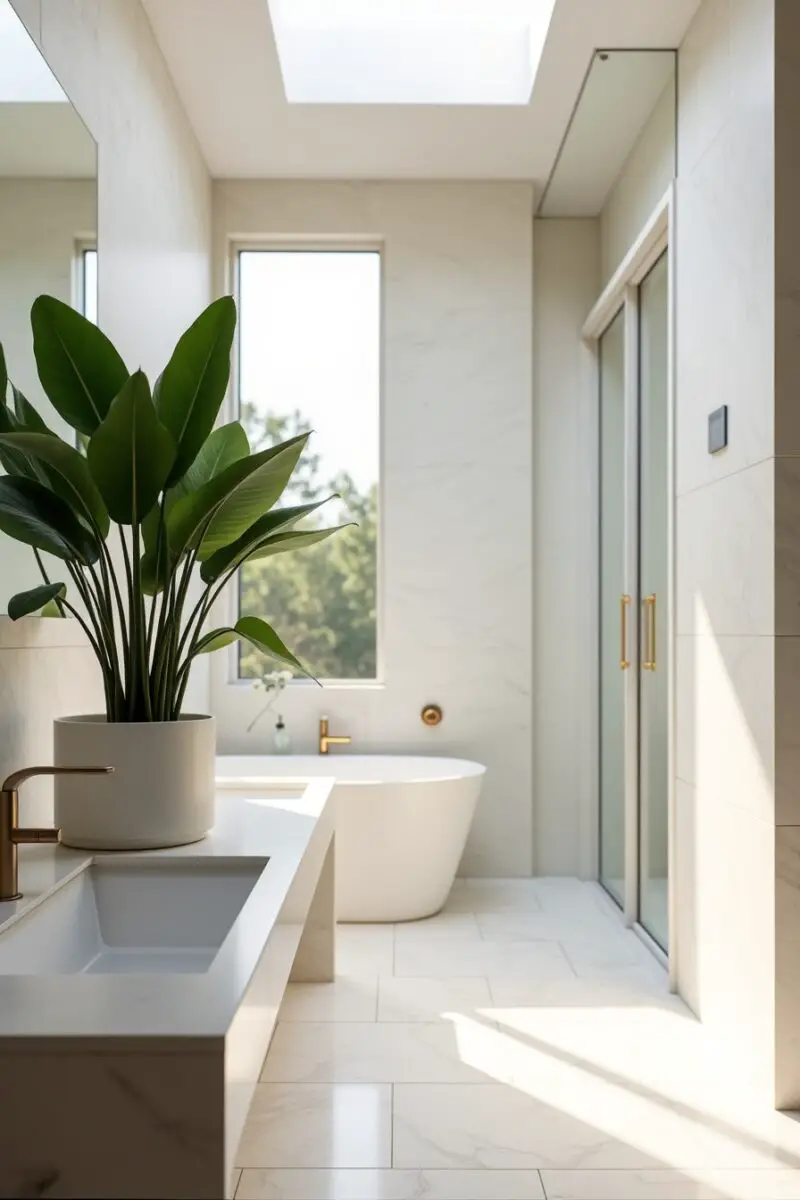
These plants feature glossy, deep green leaves arranged in a feather-like pattern on arching stems, bringing sophisticated botanical structure to bathroom spaces.
These remarkably resilient plants can survive with minimal care, making them perfect for busy households or bathroom environments with inconsistent conditions.
Your plant efficiently removes xylene, toluene, and benzene from bathroom air – chemicals commonly found in personal care products and cleaners.
These plants thrive in low to bright indirect light, adapting to nearly any bathroom lighting situation from windowless spaces to sun-filled rooms.
You’ll appreciate how plants store water in their bulbous roots, allowing them to go weeks between waterings – perfect for travellers or forgetful caregivers.
These tough plants tolerate temperature fluctuations common in bathrooms, maintaining their air-purifying abilities through steamy showers and cooler nights.
These plants grow slowly but steadily, requiring minimal maintenance while continuously improving air quality year after year.
The upright yet compact growth habit makes them ideal for bathroom countertops, toilet tanks, or floor corners where space may be limited.
You should avoid overwatering your plant, as they prefer to dry out completely between waterings – making them naturally suited to periodic bathroom neglect.
These plants maintain their lustrous appearance with minimal care, needing only occasional dusting to keep their leaves effective at air filtration.
✨Click to Get My 101 FREE Designer Room Ideas
Bamboo Palm (Chamaedorea seifrizii): The Tropical Humidity Lover


Bamboo palms showcase elegant, feathery fronds atop multiple thin stems, creating a tropical retreat atmosphere in bathroom spaces.
These graceful plants ranked highly in NASA’s Clean Air Study for removing formaldehyde, benzene, and trichloroethylene – common bathroom air pollutants.
Your bamboo palm will thrive in the natural humidity of bathrooms, while simultaneously purifying the air you breathe.
Bamboo palms prefer bright, indirect light but tolerate lower light conditions, making them adaptable to various bathroom window exposures.
The lush, tropical appearance softens bathroom aesthetics, creating a spa-like atmosphere that promotes relaxation and wellbeing.
You’ll notice bamboo palms are particularly effective at filtering out chemicals released by synthetic materials often found in bathroom products.
These palms naturally increase humidity levels, which can help prevent dry skin and respiratory irritation common in drier months.
Bamboo palms grow to an ideal medium height (typically 4-6 feet when mature), making them perfect statement plants for bathroom corners with adequate ceiling height.
The multiple stems and abundant fronds maximize air-filtering surface area, increasing the plant’s pollution-removing capabilities.
You should keep the soil consistently moist but not soggy, making regular bathroom humidity an asset to proper bamboo palm care.
These plants are pet-friendly, providing peace of mind for homes where curious animals might explore bathroom greenery.
Bamboo palms remove carbon dioxide and release oxygen throughout the day, improving the overall air quality of your bathroom and adjacent spaces.
Philodendron: The Adaptable Toxin Absorber
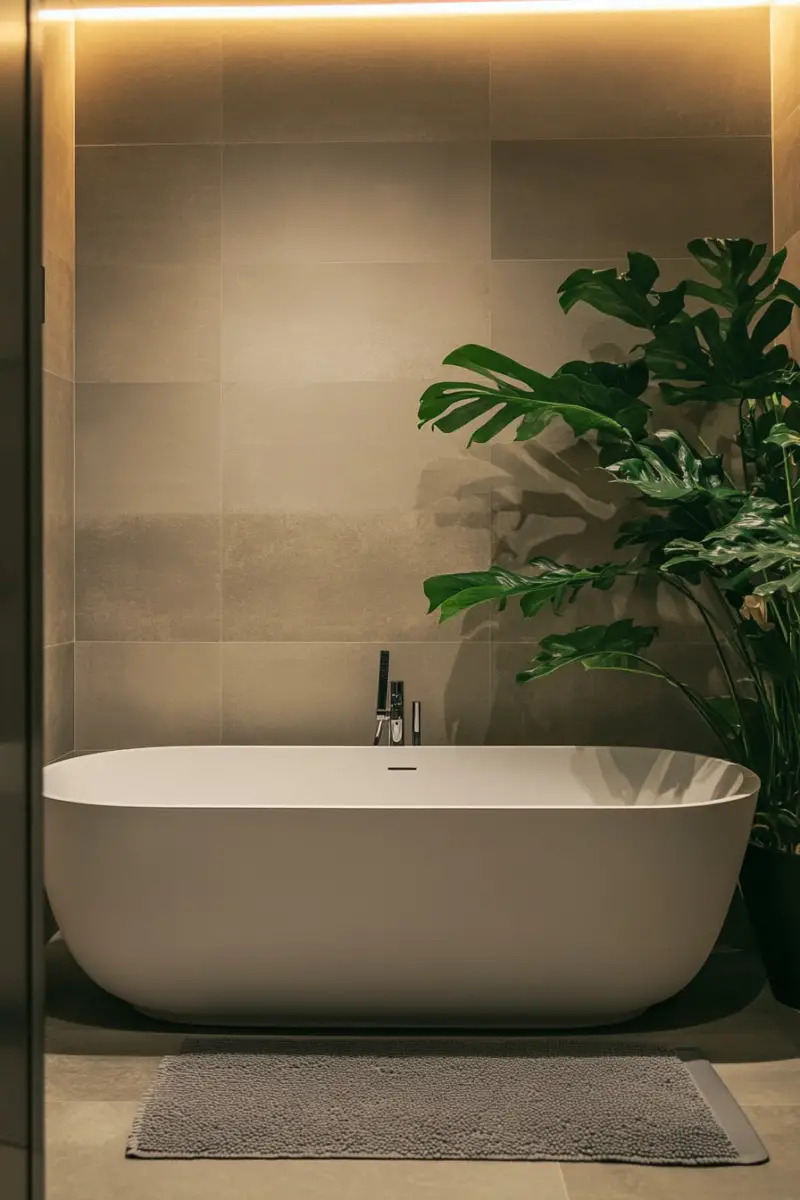
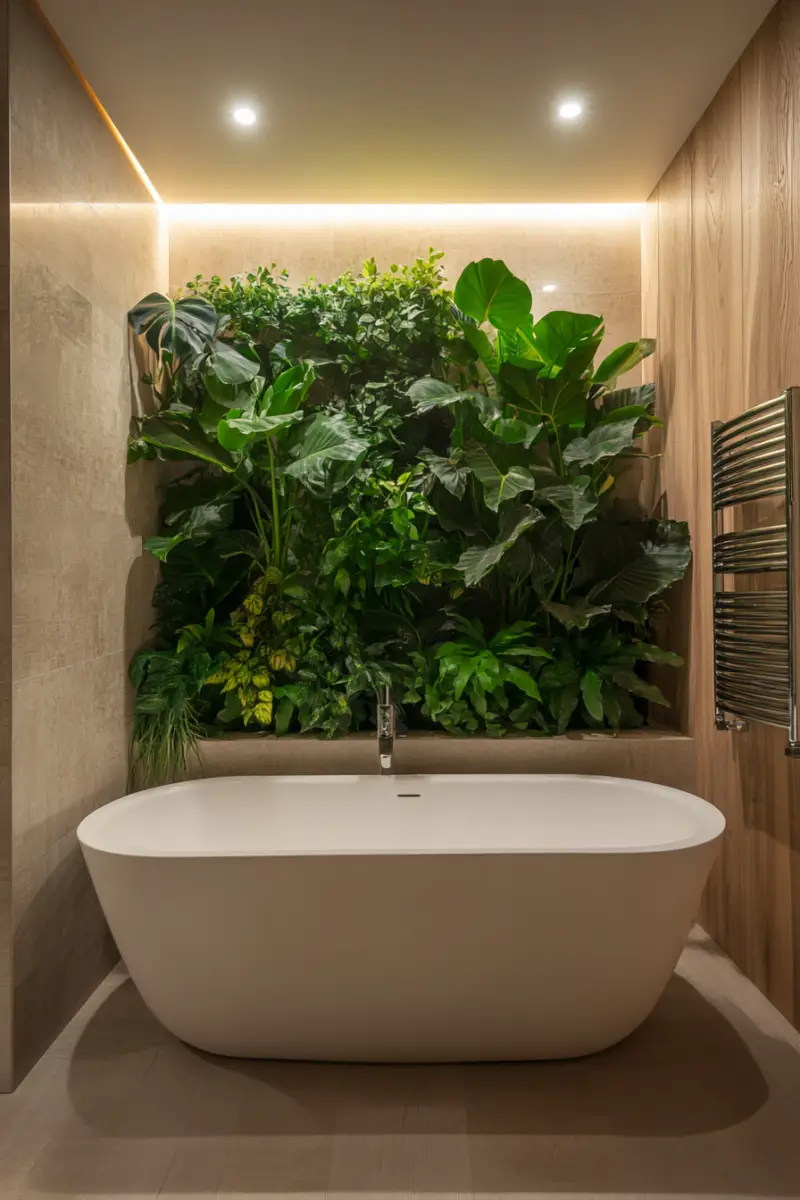
Philodendrons display heart-shaped, glossy leaves in various sizes and patterns, bringing visual interest and a touch of the tropics to bathroom spaces.
These versatile plants come in climbing, trailing, and upright varieties, allowing you to choose the perfect form for your specific bathroom layout.
Your philodendron will efficiently remove formaldehyde from bathroom air – a common pollutant released by paper products, certain fabrics, and some cleaning supplies.
Philodendrons thrive in medium to low light conditions, making them suitable for bathrooms with limited natural illumination.
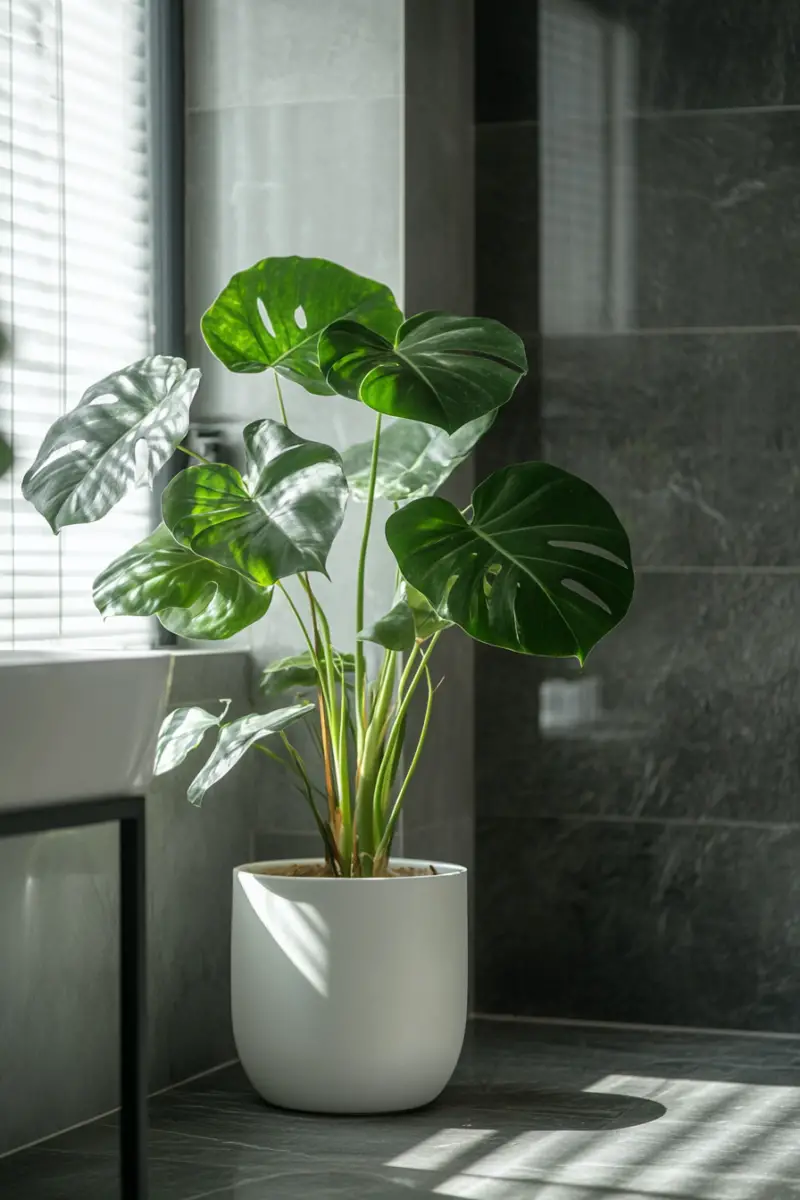
The NASA Clean Air Study confirmed philodendrons as top performers for air purification, removing significant amounts of indoor pollutants within 24 hours.
You’ll appreciate how philodendrons adapt to humidity fluctuations, maintaining their air-cleaning capabilities through steamy showers and drier periods.
These resilient plants communicate their needs clearly – yellowing leaves typically indicate overwatering, while drooping suggests thirst.
Philodendrons grow relatively quickly in favorable conditions, continuously improving their air-purifying capacity as they produce more foliage.
The trailing varieties are perfect for high shelves or hanging planters, allowing their vines to create a cascading effect that softens bathroom architecture.
You can easily propagate philodendrons by rooting stem cuttings in water, creating new plants to expand your bathroom air-purification system.
These adaptable plants filter gaseous pollutants through their leaves and roots, converting harmful compounds into nutrients they can use.
Philodendrons maintain their lustrous appearance with minimal care, requiring only occasional dusting to maximize their air-filtering efficiency.
Incorporating these air-purifying plants transforms your bathroom from a purely functional space into a rejuvenating sanctuary that actively contributes to your health.
Beyond their air-cleaning abilities, these green allies bring nature’s calming presence into one of your home’s most frequently used rooms.
Start with just one or two plants that match your bathroom’s light conditions, gradually creating your personal oxygen-rich oasis one pot at a time.

